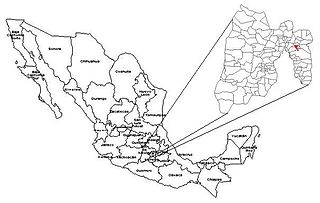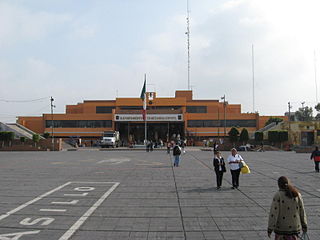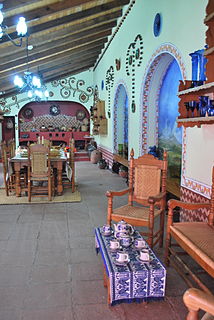
Texcoco was a major Acolhua altepetl (city-state) in the central Mexican plateau region of Mesoamerica during the Late Postclassic period of pre-Columbian Mesoamerican chronology. It was situated on the eastern bank of Lake Texcoco in the Valley of Mexico, to the northeast of the Aztec capital, Tenochtitlan. The site of pre-Columbian Texcoco is now subsumed by the modern Mexican municipio of Texcoco and its major settlement, the city formally known as Texcoco de Mora. It also lies within the greater metropolitan area of Mexico City.

Greater Mexico City refers to the conurbation around Mexico City, officially called Valley of Mexico Metropolitan Area, constituted by Mexico City itself composed of 16 Municipalities—and 41 adjacent municipalities of the states of Mexico and Hidalgo. For normative purposes, however, Greater Mexico City most commonly refers to the Metropolitan Area of the Valley of Mexico an agglomeration that incorporates 18 additional municipalities. As of 2016 an estimated 21,157,000 people lived in Greater Mexico City, making it the largest metropolitan area in North America. It is surrounded by thin strips of highlands which separate it from other adjacent metropolitan areas, of which the biggest are Puebla, Toluca, and Cuernavaca-Cuautla, and together with which it makes up the Mexico City megalopolis.

The Aztec Empire, or the Triple Alliance, began as an alliance of three Nahua altepetl city-states: Mexico-Tenochtitlan, Texcoco, and Tlacopan. These three city-states ruled the area in and around the Valley of Mexico from 1428 until the combined forces of the Spanish conquistadores and their native allies under Hernán Cortés defeated them in 1521.
The civil unrest in San Salvador Atenco of 2006 began on Wednesday, May 3, when police prevented a group of 60 flower vendors from selling at the Texcoco local market in the State of México, about 30 km (19 mi) from Mexico City. State police used violence and arrest against resisters. The flower vendors appealed to the residents of San Salvador Atenco, a small neighboring community about 25 km (16 mi) northeast of Mexico City, famous for creating their resistance organization against the development of an airport on their land in 2002.
San Salvador Atenco is the municipal seat of Atenco, in the Mexican state of Mexico. The name "Atenco" comes from a Nahuatl phrase meaning "place on the edge of water".

Chiconcuac de Juárez, typically referred to simply as Chiconcuac, is a town and municipio (municipality) in the state of Mexico, approximately 10 kilometers north of Texcoco de Mora. The name Chiconcuac derives from the Aztec word Chicome Coatl, “Seven snakes”, which was a date on the Aztec calendar.

Texcoco is a city and municipality located in the State of Mexico, 25 km northeast of Mexico City. In the pre-Hispanic era, this was a major Aztec city on the shores of Lake Texcoco. After the Conquest, the city was initially the second most important after Mexico City, but its importance faded over time, becoming more rural in character. Over the colonial and post-independence periods, most of Lake Texcoco was drained and the city is no longer on the shore and much of the municipality is on lakebed. Numerous Aztec archeological finds have been discovered here, including the 125 tonne stone statue of Tlaloc, which now resides at the Museum of Anthropology in Mexico City.
Texcoco or Tezcoco may refer to:

Chimalhuacán is a city and municipality located in the eastern part of State of Mexico, Mexico. It lies just outside the northeast border of the Federal District and is part of the Greater Mexico City urban area.

San Mateo Atenco is a city and a municipality located in the State of México in Mexico. It lies west of the Federal District near the municipality of Metepec, in the central part of the state of México, and is part of the Toluca urban area bordering the city to the east. The name Atenco is derived from the Nahuatl language. It means “In the water’s edge”, from atl(water), tentli (edge) and co (in).

Nezahualcóyotl, or more commonly Neza, is a city and municipality of State of Mexico adjacent to the northeast corner of Mexico City: it is thus part of the Mexico City Metropolitan Area. It was named after Nezahualcoyotl, the Acolhua poet and king of nearby Texcoco, and was built on the drained bed of Lake Texcoco. The name Nezahualcóyotl comes from Nahuatl, meaning "fasting coyote."

The Deposito de Evaporación Solar "El Caracol" is a large spiral-shaped retention basin located over the former lakebed of Lake Texcoco, northeast of Mexico City, in the municipio of Ecatepec de Morelos, Mexico.
Chimalhuacán is an archeological site located in the city and municipality of Chimalhuacán Atenco in the eastern part of Mexico State, Mexico. It lies just outside the northeast border of the Federal District. The name derives from the Nahuatl words “chimalli” (shield), hua and can (place), this would mean "Place of Shields".The ancient name of the city by its founders was “Chimalhuacantoyac”.The word Atenco, is also Nahuatl; A, “water”; tentli, “lip” and co, “place”, hence would mean “at the water side”.

Ecatepec, (Spanish[ekateˈpek] once officially Ecatepec de Morelos, is a city and municipality in the State of Mexico. Both are usually known simply as "Ecatepec". The city is practically co-extensive with the municipality, with the city's 2005 population of 1,687,549 being 99.9% of the total municipal population of 1,688,258. The provisional population at the 2010 Census was 1,658,806. The city forms the most populous suburb of Mexico City and the fifteenth suburb in the world in population. It is also Mexico's most populous municipality after Iztapalapa, Mexico City.
Federal Highway 136D is a toll highway connecting the communities of Peñón and Texcoco in the State of Mexico. The 16.5-kilometre (10.3 mi) road is operated by Concesionaria PAC, S.A. de C.V. and Operadora Metropolitana de Carreteras, S. A. de C. V., which charge cars 42 pesos to travel the full length of the road.

César Octavio Camacho Quiroz is a Mexican lawyer and politician affiliated with the Institutional Revolutionary Party. He served as Governor of the State of Mexico between 1995 and 1999, as Senator of the LVIII and LIX Legislatures of the Mexican Congress, and as Deputy of the LX and LXIII Legislatures, all representing the State of Mexico, and as president of the PRI between 2012 and 2015.

Mexico City's New International Airport (NAICM) was announced in the State of the Union address of Mexican president Enrique Peña Nieto on September 2, 2014, and was the largest public infrastructure work in Mexico in a century. The new airport was set to replace current Benito Juárez International Airport, the busiest airport in Latin America transporting 41.7 million passengers in 2016.

The State of Mexico produces various kinds of handcrafted items. While not as well documented as the work of other states, it does produce a number of notable items from the pottery of Metepec, the silverwork of the Mazahua people and various textiles including handwoven serapes and rebozos and knotted rugs. There are seventeen recognized handcraft traditions in the state, and include both those with pre Hispanic origins to those brought over by the Spanish after the Conquest. As the state industrializes and competition from cheaper goods increases, handcraft production has diminished. However, there are a number of efforts by state agencies to promote these traditions both inside and outside of Mexico.
Region VII is an intrastate region within the State of Mexico, one of 16. It borders the states of Mexico City and Morelos in the south corner of the state. The region comprises thirteen municipalities: Ocoyoacac, Lerma, Capulhuac, San Mateo Atenco. It is largely rural.













